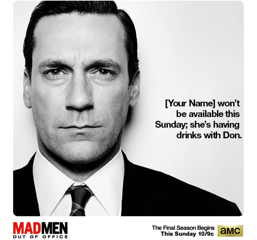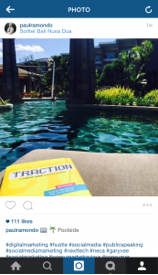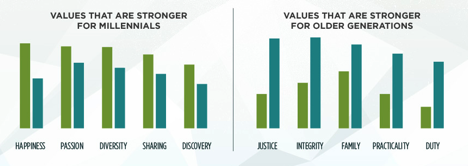Millennials: Who are they? What do they like? And how do they differ from previous generations, especially in terms of digital purchasing expectations and behavior?
First coined in by historians Neil Howe and William Strauss in 1991, the term millennial represents the cohort of people born between 1980 and 2000 (plus or minus a few years).
Howe and Strauss chose “millennial” because research for their book Generations, which was released just eight years into the millennial age, indicated that this generation would be “drastically different [from] the one before and therefore needed a distinct name. Plus, the oldest [millennials] would graduate high school in 2000, a date that loomed large in the 90s.”
One of the most significant factors contributing to the uniqueness of this generation stems from the way millennial children were raised, with much more “structure and protection” than the generation that precedes it although Howe would argue that all generations possess distinct attributes (generations are like snowflakes; no two are exactly alike).
Nevertheless, millennials differ in a number of ways from their mostly Baby Boomer parents. Plus, they demonstrate some serious purchasing power (presumed to spend over $200 billion a year, according to some estimates). And as a result of these differentiating factors, the face of business is changing, and on-the-ball marketers are adopting strategies that factor in the distinctive behavior, values, and perceptions of the millennial generation.
What Savvy Marketers Need to Know about Millennials
So, what are some of the stand-out qualities of millennials that marketers should consider?
Millennials are not makin’ it rain
Whether they’re still in college, looking for their first job, getting married, or starting a family, many millennials are at a point in their lives during which transitions and big changes are likely to occur.
Consequently, money is often tight for millennials and marketers should take this into account with their marketing campaigns. For example, marketers could offer free products or “age-driven discounts” every now and then, similar to how some companies provide discounts for students, active-duty military, and senior citizens. It’s about showing empathy and appreciation for the millennial consumer’s age and current stage of life.
Millennials like to exhibit their bragging rights
Millennials are high achievers. They are accustomed to celebrating milestones. They enjoy receiving praise. And through social media, millennials have a platform to trumpet their achievements and experiences –from momentous occasions, like getting engaged, to more mundane activities, like preparing a home-cooked meal—all while garnering positive feedback from their peers through “likes,” comments, and re-tweets.
From a marketing standpoint, what this means is marketers need to be able to answer the following question:
What can I do to make millennials want to brag about my offer?
Additionally, millennials typically have one or two preferred social networks that they engage with more regularly than others. Therefore, marketers should spread their message across multiple platforms and adopt a more holistic approach with their campaigns in order to reach as many millennials as possible.
Millennials are snap decision-makers
Most marketers are familiar with the concept of the “elevator pitch”—a roughly 30-second long speech that summarizes your offer and value proposition and gets customers interested in learning more. Well, the timeframe to grab millennials’ attention is even shorter—with millennials, it’s an elevator pitch in a two-story building.
 Elyse Dupre: “Millennials want to know what the product is and how it’s going to benefit them right away. It’s just the culture we grew up in. Information has always been just a click away. If a brand can’t answer a millennial’s question, the millennial will take his or her business elsewhere.
Elyse Dupre: “Millennials want to know what the product is and how it’s going to benefit them right away. It’s just the culture we grew up in. Information has always been just a click away. If a brand can’t answer a millennial’s question, the millennial will take his or her business elsewhere.
My brother and I used to say, ‘patience is a waste of time,’ and while it certainly isn’t the most virtuous saying, it does reflect the want-it-now millennial lifestyle. Brands need to make sure that their product information is available in all forms—mobile, in-store, online—so that millennials can access it anytime, anywhere at the drop of a hat.
Also, marketers need to get to the point. If I have to watch a video, create an account, and wait for an email confirmation, I’m probably going to lose interest.”
Millennials’ Marketing Preferences
Recently, NPR hosted a focus group comprised of two dozen Southern Californian millennials of varying races, genders, ages, and occupations to discuss which brands and advertisements they liked and disliked.
Below, you’ll find a selection of quotes and a summation of the marketing qualities that were stressed during the group’s conversation.
Top marketing qualities millennials dislike:
When it comes to advertising, there are certain qualities that millennials do not respond to well—specifically, a lack of authenticity and misrepresentation.
Mamie Young: “One campaign that really turned me off was the Kia campaign with the hip-hop hamsters. I think they’re trying so hard. And that kind of turns us off because there’s a lack of authenticity. When you want us to buy a car, you’re trying too hard when you’re putting people in hamster costumes and hip-hop dancing and driving through neon-light cities. It’s just too much.”
Sarah Harburg-Petrick: “I wish they would stop using women as props. Women are not props, they are not headless. They are people who have feelings, desires and a lot of cash to spend on goods. So, stop using women as if they are these soulless, shoe-buying, pink-loving, shrink-it-and-forget-about-it things. It’s so frustrating. A soda company basically said this is man diet soda, and women can’t apply. It was so frustrating!”
Kenneth Mackins: “I’m super sick of seeing ads with people who are only 5 foot 8 inches to 6 feet tall and weigh, if they’re a woman, 100 pounds, and a man, maybe 150.”
Based on this evidence, in order to appeal to millennials, marketers should avoid using gimmicks that come across as “trying too hard” and instead foster a more genuine approach to promoting their brand or offer. Plus, they should be more inclusive in their casting choices as well as in the messages they deliver and they should stop relying on antiquated stereotypes to sell their goods.
Top marketing qualities millennials enjoy:
Given the qualities that the participants did not enjoy, it’s unsurprising that this group of millennials preferred those advertisements that conveyed humility, subtlety, and diversity.
James McOmber: “An Ikea commercial, where they just let a bunch of little cats roam around Ikea and make themselves comfortable on the furniture. The end was something like, ‘A place to call home,’ or something about home. I personally just liked it because it wasn’t too loud or in your face. It kind of just stayed quiet. It was subtle. I like subtle.”
Garrett Black: “One of my favorite ads that I’ve seen recently are the [Lipton] Brisk ads: ‘not half bad.’ Because everybody’s trying to throw it in your face and say, ‘This is the best thing ever, this is great.’ No one just admits, ‘Yeah it’s pretty good and you should try it.’ That has probably been more effective than anything else, just the complete undersell.”
Amy Sandefur: “I think Cheerios had a great marketing campaign, especially their focus on homosexual marriages and children and bringing all of that together. And I think that awareness points to things that are happening socially. I liked that they put out an ad recently where I couldn’t even tell that the ad was for Cheerios until the end because the message was completely different. I think it’s interesting that companies feel social responsibility to put good things out in the world.”
Millennials don’t want to be hit over the head with a caffeinated sales approach that relies on hype and buzz words; they want honesty and authenticity. And if a marketing campaign incorporates a dash of social awareness, then more power to it.
The Best Apps for Marketing to Millennials
Millennials consume content in a big way, and most of their content consumption occurs via their phone or tablet. A Pew study reports that “mobile devices are the primary access point to the Internet for more than 50 percent of younger millennials.” Moreover, an Experian study found that millennials use their phones 14 percent more than older consumers to engage in activities, such as texting, communicating and keeping up with their friends and family on social media, and interacting with apps.
 Justin Christianson, co-founder of Conversion Fanatics: “In market segments ranging from 18-years-old to 34, be sure you are thinking mobile. Finding ways to integrate your advertising in a native fashion into mobile applications and programs will continue to be the key to get in front of the millennial audience.”
Justin Christianson, co-founder of Conversion Fanatics: “In market segments ranging from 18-years-old to 34, be sure you are thinking mobile. Finding ways to integrate your advertising in a native fashion into mobile applications and programs will continue to be the key to get in front of the millennial audience.”
On average, millennials have 21 apps per phone, including apps for games, music, and social networking. Therefore, considering millennials’ penchant for mobile devices, marketers should take a “mobile-first” approach to engage with millennials, “because the technology is an extension of their personalities and something they interact with on a daily basis.”
Furthermore, marketers need to catch millennials’ attention quickly, as millennials respond better to images and bite-sized portions of text; plus, most of the popular mobile apps are visual-centric.
Below, you’ll find a list of four of the best apps used for marketing to millennials:
Snapchat
Snapchat now includes a range of new features, including Live Stories, Discover, and most recently, geo-filters, which are location-based in-app stickers that users can select and add to their snaps in order to tag their current location, event, or activity.
Resonating with millennials’ desire to differentiate their content from that of other people, tagging has become a popular social media trend, and geo-filters take text-based tagging to the next level by enabling users to distinguish their content by adding engaging context to their snaps.
Additionally, users have to activate the location service on their phones in order for Snapchat to discern whether their location falls within the parameters of a particular geo-filter’s boundaries. This makes each geo-filter somewhat exclusive and content-sharing becomes even more gratifying for millennials, as geo-filters act as the antidote to the FOMO (“fear of missing out”) bug.
Furthermore, advertising through sponsored geo-filters works well with millennials because sponsored geo-filters integrate into the Snapchat user-experience more organically and less intrusively. Plus, word-of-mouth recommendations are very powerful with millennials.
 Tai Tran: “This summer, McDonalds became the first advertiser to create sponsored Snapchat’s geo-filters. McDonald’s geo-filters blend nicely with the other geo-filters that users can choose from—when a user is nearby a McDonald’s, they can now decorate their Snaps with falling golden fries and a cheeseburger.
Tai Tran: “This summer, McDonalds became the first advertiser to create sponsored Snapchat’s geo-filters. McDonald’s geo-filters blend nicely with the other geo-filters that users can choose from—when a user is nearby a McDonald’s, they can now decorate their Snaps with falling golden fries and a cheeseburger.
With McDonalds choosing to advertise through the geo-filters instead of through the Discover channels, it successfully engages millennials because adding geo-filters to snaps make the advertisement customizable and personal for each user. In addition, each time a snap with the geo-filter is sent, the user on the receiving end will also see it, thus increasing McDonald’s awareness.”

Millennials love Twitter for a number of reasons: Twitter alleviates boredom through laughter; tweeting about live experiences and events, such as the Oscars, makes them more fun; and Twitter allows users to document their stories and perspectives in real-time.
Given these inclinations, marketers should take the actions listed below to more effectively engage with millennials and use the following examples provided by Aaron Moy as inspiration:
- Share funny content when appropriate and relevant: “For example, while ‘5SOS’ may not be a family term to some of us, Denny’s knew that it stood for 5 Seconds of Summer, an Australian pop-punk band beloved by millennials. They include the reference in this funny tweet.”
2. Use a calendar to keep track of popular events and strategize ways to engage in real-time: “For example, Trident and other brands quickly generated Tweets in response to plays at the World Cup.”
3. Let millennials interact with your brand while simultaneously sharing information about themselves: “For example, @MadMen_AMC came up with a sophisticated way for users to tweet that they would be watching the Mad Men season finale last April: they enabled users to customize an image of a Mad Men character that stated the user would be ‘out of office’ during the show.”

More and more, images are becoming a core element of online communication and Instagram perfectly serves this predilection for visuals. As of September, Instagram has over 400 million monthly active users, and according to the Pew Institute, “53% of people aged 18-29, which is the majority of the millennial generation, use Instagram.”
Instagram allows users to brilliantly showcase even mundane experiences in a way that’s both beautiful and compelling, which taps into millennials’ YOLO (“you only live once”) mentality, as cheesy as it may sound, and the way they value having experiences over owning material goods.
One of the most commonly cited tips for marketers trying to reach millennials via Instagram is to “keep it real.” Matt Britton, founder and CEO of New York-based MRY, shares the following insights:
 Matt Britton: “Nobody wants to see an ad on Instagram, period. Instagram is all about authenticity and telling the world what you are, as a person or as a brand, one photo at a time. So before posting, ask yourself whether your photo comes off as authentic or commercialized. If it doesn’t feel 100 percent real, don’t post it.
Matt Britton: “Nobody wants to see an ad on Instagram, period. Instagram is all about authenticity and telling the world what you are, as a person or as a brand, one photo at a time. So before posting, ask yourself whether your photo comes off as authentic or commercialized. If it doesn’t feel 100 percent real, don’t post it.
This isn’t the channel to re-post your print ads. It’s the channel to tell your brain story authentically, the same way your customers tell and share their own stories. What does your brand care about? Where does your brand go? Who does it spend time with?
The mantra of YouthNation for talking on Instagram is ‘show us—don’t tell us.’”
Another Instagram best-practice is to optimize the power of “white space” in both your Instagram captions and bio. Lengthy passages of text discourage users from reading your information, but by separating your copy with line breaks, you increase users’ level of attention and engagement.

Adding line breaks to Instagram captions is a little bit tricky, however. Paul Ramondo of RamondoMedia lets you in on the secret:
 Paul Ramondo: “So how do you do it?
Paul Ramondo: “So how do you do it?
- Create your desired text, complete with the line breaks/white space you want.
- In order for your paragraph to work, you need to remove any characters, spaces or emojis following your text.
- Publish the images and BOOM, you now have spaces breaking up your text-heavy caption—just nobody call the grammar police.”
As a final suggestion for marketers trying to reach millennials with Instagram, stay relevant when it comes to cultural trends. Millennials have been responsible for pop-culture movements, such as “Throwback Thursday” (#TBT), which spread like wildfire and subsequently became part of the common vernacular. So marketers need to remain up-to-date on these types of trends and then leverage opportunities to demonstrate their brand’s relevance.
Vine
While Vine’s level of influence certainly pales in comparison to Twitter and Instagram, the video app does still hold significant clout with millennials, reaching 14% of the total digital population in the U.S. And this may seem like some potatoes, but the Vine community is highly engaged and active, with more than 100 million people watching Vine videos every month and Vine users sharing 8.333 videos each minute.
Plus, Vine doesn’t limit you to being able to share your videos only on its network; you can get even more views by sharing your content on Facebook and Twitter as well. So don’t underestimate the marketing potential that Vine could have for your brand and offers, especially if you’re targeting younger millennials.
Jeff Fromm: “A few ways brands can use Vine include:
- To show the action
Vine’s format is perfect for showing what’s going on and conveying excitement…An example includes the San Francisco Giants, which recorded a Vine of the opening pitch earlier this [year.]
- To show company culture (and have a little fun)
[Recently], Urban Outfitters used Vine to create a Vine of a god giving a high-five. It received more than 2,500 ‘likes.’
- To show your products
Gap used Vine to showcase a new product available in select stores.”

Another innovative suggestion for how brands can use Vine is to create a DIY video—whether it’s an overview of a project or just a quick tip. Vines can be much more engaging compared to a tweet or Facebook post.
Also, marketers can use Vine to give customers a behind-the-scenes peek at the happenings of their company, thus demonstrating a different side of their brand and a little something special.
Conclusion
The millennial generation is unique—there’s no doubt about it. Millennials have distinct values, perspectives, goals, and behaviors. According to Forbes, “Millennials rank inward-focused values like happiness and discovery higher than collective-focused values that mark the Baby Boomers generation, such as family and practicality.”

Plus, millennials have distinct buying patterns, which make marketing to millennials a horse of a different color. But with more than 80 million millennials in the United States—representing almost one-quarter of the entire population—along with the purchasing power of $200 billion each year, millennials are without a doubt the “most lucrative market.”
Therefore, marketers need to make millennials a priority. And by learning what makes this generation tick, marketers can foster a more relevant and relatable connection between millennials and their brand.
Have something to add? Leave us a comment.
Be sure to like, share and subscribe.






